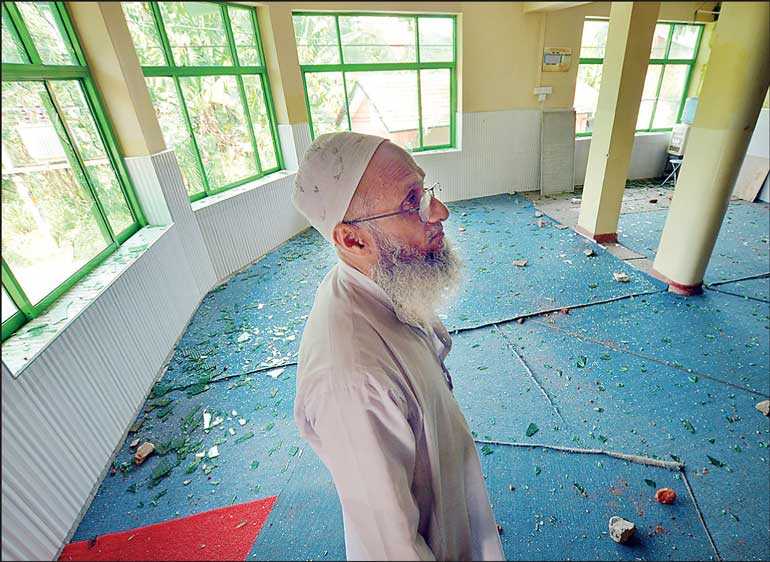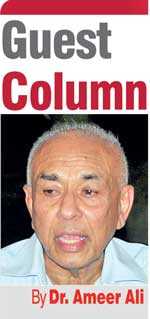Thursday Apr 25, 2024
Thursday Apr 25, 2024
Thursday, 10 January 2019 00:23 - - {{hitsCtrl.values.hits}}

When I published an earlier piece on this topic on 30 December 2018, I did not intend to add another part to it. However, what happened in the Court when one of the culprits was produced before the Magistrate has compelled me to add another.
In the first part, I drew attention to the mytho-historic mindset that produces such despicable acts. I also provided evidence that such acts were contrary to the ‘cosmopolitan worldliness’ that Muslims evinced during their High Noon in Baghdad, Cordova and Delhi.
In particular, the Spanish convivencia was the product of Muslim rule, and din ilahi of Mogul Emperor Akbar was equally symbolic of his religious tolerance. The Mu’tazili philosophers of 9th and 10th centuries and Sufi mystics who followed in their footsteps were exemplars in religious tolerance and understanding of other philosophies.
I do not deny at the same time that there were numerous episodes of inter-religious hatred and bloody massacres in history. In the history of Islam however, the rise of different degrees of orthodoxy after the 11th century, as I pointed out in part 1, was a counter revolution that crippled the previously reigning cosmopolitan and pluralist tendencies.
Even today in Indonesia, the largest Muslim populated country in the world, Muslims are proud to demonstrate their enchantment at and readiness to protect and preserve the largest Buddhist temple in the world at Borobudur. Not only that, I was pleasantly surprised one day to witness a Muslim sculptor in Java carving out in stone miniature replicas of this ancient temple and Buddha statues to fulfil an export order from Germany.
It is on record that Buddhism and Islam intermingled and cross-pollinated with each other all along the Silk Road (Johan Elverskog, Buddhism and Islam on the Silk Road, University of Pennsylvania Press, 2010). Against such reality, the destruction of Buddhist and Hindu statues in Mawanella and Kurunegala-Pothuhera by a group of 20- to 30-year-old Muslim ignoramuses is the latest and ugliest page of a counter revolution started centuries ago. The age group is significant and I will explain why later.
I want to start with a statement, as reported in newspapers, by one of the bigots according to which he was driven to destroy the statues because in his reading of the Quran he came to understand that there can be only one God, Allah, and therefore there cannot be any other including the Buddha. Hence, in his thinking Buddha statues must be destroyed.
This is typical of those who read the Quran literally, without any other knowledge outside that text such as history or sociology or other sciences, and without the ability to contextualise the text and textualise the context simultaneously. The entire blame for this shortcoming should be placed at the doors of religious education imparted in the traditional madrasas by narrowly-trained teachers.
I am afraid that even courses taught in Islamic studies in Sri Lankan universities lack advanced knowledge and critical thought, and are no more than an exercise in systematic transmission of received wisdom. It is time Muslim leadership including Muslim educationists attend to this issue in earnest if the community were to avoid producing more bigots.
Moreover, that there is a rising tide of fundamentalism in all major religions in the country is beyond dispute. This is why intra-religious and inter-religious dialogues need be organised by both government as well as civil society groups. This is imperative if Sri Lanka wants to protect its social and religious harmony without destroying its pluralist make up.
The age cohort of the culprits is significant because this is the generation that was born and grew up in the international environment of Wahhabi/Salafi fundamentalism. This 18th century ultra-conservative version of Islam was given free license by US and its allies to spread its wings and fly out of the Arabian Desert in order to check the then rising tide of Iranian radicalism that was threatening to topple all monarchical regimes in the Middle East.
With super power blessing and mounting petro dollars in Arab coffers, Saudi sponsored Wahhabi/Salafism ultra-conservatism entered almost every country where Muslims were present in sizeable numbers. Mosques were built and expanded, madrasas were established, religious texts written and printed in Saudi Arabia were distributed through local agencies and even religious teachers and priests were trained in Saudi educational institutions. 
This fundamentalist mission produced a generation of Muslim youth who believed in the globalisation of Islam in its Wahhabi image. Not surprisingly therefore, it was from this generation extremist groups like Al-Qaeda and ISIL for example found their recruits. There is no denying the fact that fundamentalist tendencies in Sri Lanka is a post-1970 phenomenon. It is this phenomenon that has damaged the millennium old peaceful coexistence between Muslims and Buddhists in this country.
After the Mawanella bigotry a number of articles appeared, mostly in Tamil dailies, explaining fairly correctly the true picture in Islamic literature with regard to other religions and statues. This is to be welcome, but the question is, how many are reading these writings? Do they reach the Muslim public?
The ACJU must realise that it has a more powerful avenue to reach Muslim masses if it is willing to counter the spread of literalist Islam. This is the Friday sermon listened by hundreds of thousands every week. This is being wasted at the moment by meaningless repetition of age-old stories and irrelevant issues.
To utilise this occasion fruitfully the imams who deliver these sermons should be adequately trained and be knowledgeable not only in Islamic scriptures but also and more importantly about developments in the immediate surroundings. In this day and age of instant communication ACJU and imams under its control must be able to coordinate their activities particularly regarding the topics and substance of weekly sermons.
In addition, the madrasas that train these imams need urgent reform. Madrasas have an important role to play in the character building of young Muslims. However, the curriculum in these religious schools needs modernisation. To ignore this need is to keep religious knowledge irrelevant to tackle emerging problems.
In some countries madrasas have become the breeding ground for bigots. To begin with, I will strongly recommend ACJU hierarchy and Muslim educationists to read the book ‘What is a Madrasa?’ authored by Ebrahim Moosa (Edinburgh University Press, 2015), to understand the issue I am referring to. Moosa himself began his education in a madrasa before becoming professor in an American university.
Enforcing law and order can be short-term remedies to check extremist elements in the community, but long-term measures cannot be postponed if Muslims are to recover their lost peace in Sri Lanka.
(The writer is attached to the School of Business and Governance, Murdoch University, Western Australia.)